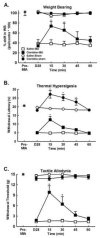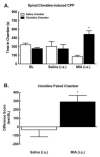Ongoing pain in the MIA model of osteoarthritis
- PMID: 21241772
- PMCID: PMC3395079
- DOI: 10.1016/j.neulet.2011.01.027
Ongoing pain in the MIA model of osteoarthritis
Abstract
Osteoarthritis (OA) is a chronic pain condition characterized by pain during joint use as well as pain at rest (i.e., ongoing pain). Although injection of monosodium iodoacetate (MIA) into the intra-articular space of the rodent knee is a well established model of OA pain that is characterized by changes in weight bearing and hypersensitivity to tactile and thermal stimuli, it is not known if this procedure elicits ongoing pain. Further, the time-course and possible underlying mechanisms of these components of pain remain poorly understood. In these studies, we demonstrated the presence of ongoing pain in addition to changes in weight bearing and evoked hypersensitivity. Twenty-eight days following MIA injection, spinal clonidine blocked changes in weight bearing and thermal hypersensitivity and produced place preference indicating that MIA induces ongoing and evoked pain. These findings demonstrate the presence of ongoing pain in this model that is present at a late-time point after MIA allowing for mechanistic investigation.
Copyright © 2011 Elsevier Ireland Ltd. All rights reserved.
Figures


Similar articles
-
Afferent drive elicits ongoing pain in a model of advanced osteoarthritis.Pain. 2012 Apr;153(4):924-933. doi: 10.1016/j.pain.2012.01.022. Epub 2012 Mar 2. Pain. 2012. PMID: 22387095 Free PMC article.
-
Monosodium iodoacetate-induced osteoarthritis produces pain-depressed wheel running in rats: implications for preclinical behavioral assessment of chronic pain.Pharmacol Biochem Behav. 2011 Mar;98(1):35-42. doi: 10.1016/j.pbb.2010.12.009. Epub 2010 Dec 10. Pharmacol Biochem Behav. 2011. PMID: 21147151 Free PMC article.
-
Spontaneous firing in C-fibers and increased mechanical sensitivity in A-fibers of knee joint-associated mechanoreceptive primary afferent neurones during MIA-induced osteoarthritis in the rat.Osteoarthritis Cartilage. 2012 Apr;20(4):305-13. doi: 10.1016/j.joca.2012.01.002. Epub 2012 Jan 10. Osteoarthritis Cartilage. 2012. PMID: 22285737
-
Dissecting the contribution of knee joint NGF to spinal nociceptive sensitization in a model of OA pain in the rat.Osteoarthritis Cartilage. 2015 Jun;23(6):906-13. doi: 10.1016/j.joca.2015.01.010. Epub 2015 Jan 24. Osteoarthritis Cartilage. 2015. PMID: 25623624 Free PMC article.
-
Osteoarthritis pain: What are we learning from animal models?Best Pract Res Clin Rheumatol. 2017 Oct;31(5):676-687. doi: 10.1016/j.berh.2018.03.003. Epub 2018 Apr 26. Best Pract Res Clin Rheumatol. 2017. PMID: 30509413 Free PMC article. Review.
Cited by
-
Potentiating TRPA1 by Sea Anemone Peptide Ms 9a-1 Reduces Pain and Inflammation in a Model of Osteoarthritis.Mar Drugs. 2023 Nov 28;21(12):617. doi: 10.3390/md21120617. Mar Drugs. 2023. PMID: 38132938 Free PMC article.
-
Pilot comparison of outcome measures across chemical and surgical experimental models of chronic osteoarthritis in the rat (Rattus norvegicus).PLoS One. 2022 Nov 21;17(11):e0277943. doi: 10.1371/journal.pone.0277943. eCollection 2022. PLoS One. 2022. PMID: 36409758 Free PMC article.
-
Preclinical approaches to evaluate Uncaria tomentosa bark extract loaded FDOFs using osteoarthritis models.Heliyon. 2024 Oct 2;10(19):e38813. doi: 10.1016/j.heliyon.2024.e38813. eCollection 2024 Oct 15. Heliyon. 2024. PMID: 39430457 Free PMC article.
-
Mechanisms of chronic pain in osteoarthritis.Curr Rheumatol Rep. 2012 Dec;14(6):549-56. doi: 10.1007/s11926-012-0279-x. Curr Rheumatol Rep. 2012. PMID: 22798062 Review.
-
A commentary on modelling osteoarthritis pain in small animals.Osteoarthritis Cartilage. 2013 Sep;21(9):1316-26. doi: 10.1016/j.joca.2013.06.003. Osteoarthritis Cartilage. 2013. PMID: 23973146 Free PMC article. Review.
References
-
- Argoff CE. Conclusions: chronic pain studies of lidocaine patch 5% using the Neuropathic Pain Scale. Curr Med Res Opin. 2004;20(Suppl 2):S29–31. - PubMed
-
- Burch F, Codding C, Patel N, Sheldon E. Lidocaine patch 5% improves pain, stiffness, and physical function in osteoarthritis pain patients. A prospective, multicenter, open-label effectiveness trial. Osteoarthritis Cartilage. 2004;12:253–255. - PubMed
-
- Chandran P, Pai M, Blomme EA, Hsieh GC, Decker MW, Honore P. Pharmacological modulation of movement-evoked pain in a rat model of osteoarthritis. Eur J Pharmacol. 2009;613:39–45. - PubMed
Publication types
MeSH terms
Substances
Grants and funding
LinkOut - more resources
Full Text Sources
Medical

